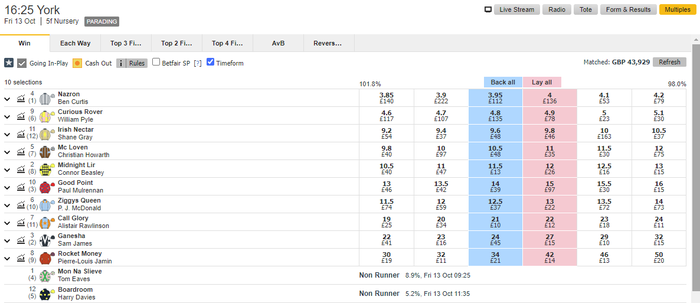 The launch of Betfair in June 2000 signalled a seismic shift in the online betting industry, as punters began to flock to the new peer-to-peer betting system, which cut out the bookmaker and enabled bettors to both back and lay selections. Operating on a general 5% commission on winning bets and offering hugely competitive markets, most will agree that the explosion of the exchange has positively impacted the modern betting landscape.
The launch of Betfair in June 2000 signalled a seismic shift in the online betting industry, as punters began to flock to the new peer-to-peer betting system, which cut out the bookmaker and enabled bettors to both back and lay selections. Operating on a general 5% commission on winning bets and offering hugely competitive markets, most will agree that the explosion of the exchange has positively impacted the modern betting landscape.
However, the Betfair story has not been without controversy, and one of the most divisive issues emerged in 2008 with the introduction of the Betfair Premium charge. Beginning at 20% of total profits – potentially rising to 40% or even 60% – this charge is targeted at consistently profitable, relatively high-volume users. Most Betfair customers have remained unaffected by the Premium Charge and are unlikely to come across it throughout their time using the site. It is also important to note that the charge applies only to profits gained when using the exchange arm of the site. So, how do these increased charges work?
Why Was the Charge Introduced?

The most likely explanation is that the Premium Charge was designed to correct a perceived flaw in the Betfair commission system, which commonly resulted in traditional gamblers paying more in commission, in percentage terms, than customers who follow a trading-based strategy.
How much this applies will, of course, vary widely between customers, but a simple example serves to illustrate the principle behind this theory. First, let’s take a look at a small sample of theoretical results for a horse racing punter who gambles in the traditional manner, i.e. each bet will result in either a win or the loss of the entire stake:
| Race | Stake | Odds | Result | Commission (5%) |
|---|---|---|---|---|
| 1 | £100 | 2.2 | £120.00 | £6 |
| 2 | £100 | 2.2 | -£100.00 | 0 |
| 3 | £100 | 2.2 | £120.00 | £6 |
| 4 | £100 | 2.2 | -£100.00 | 0 |
| 5 | £100 | 2.2 | £120.00 | £6 |
| 6 | £100 | 2.2 | -£100.00 | 0 |
| Total | £600 | – | £60 (net) | £18 |
As we can see, our punter only pays the 5% commission on his winning bets – his losing bets incur no additional costs. However, the important figures to note here are his total profit of £60 and total commission of £18. At the end of our six-race sample, the punter has paid only 5% per winning bet, but when taken together, his total commission amounts to a hefty 30% of his overall profit.
Now to the case of the trader. Rather than simply placing a bet and awaiting the outcome, traders aim to profit from every market they enter. This is most commonly achieved by backing one or more runners at what they perceive to be a big price and then laying the same runner(s) when the price shortens, e.g., if you can back a horse at 6/1 and then lay it at 4/1, you could secure a profit no matter what the result. That is a simplistic example of a trading world populated by ever more complicated algorithms and automated betting bots but illustrates the basic principle. Let’s look at a six-race sample of a simple trading strategy.
| Race | Stake | Result | Commission (5%) |
|---|---|---|---|
| 1 | £100 | £10.00 | £0.50 |
| 2 | £100 | £10.00 | £0.50 |
| 3 | £100 | £10.00 | £0.50 |
| 4 | £100 | £10.00 | £0.50 |
| 5 | £100 | £10.00 | £0.50 |
| 6 | £100 | £10.00 | £0.50 |
| Total | £600 | £60 (net) | £3 |
The total stakes and overall profit are identical to the gambler in the first example. However, the total commission paid is rather different. Whereas our gambler’s steady stream of 5% charges ultimately amounted to a 30% charge on total profits, for the trader, this rate remains at 5% throughout. With an ever-growing number of traders on Betfair, it seems likely that the Premium Charge was introduced to correct this perceived imbalance. It all makes sense in theory, but a more cynical view would be that Betfair spotted a route to extract more profit from the platform to line their pockets and satisfy their shareholders.
Who Pays the Premium Charge?
Whilst controversial, this charge affects only a small percentage of users – estimated at just 0.50% of all Betfair customers according to their help page. You will only be affected by the Premium Charge if you meet all of the following criteria:
- Your account is in profit over the lifetime of the account
- The total charges generated (i.e. the total amount you have paid in commission) is less than 20% of your total profits
- You have bet/traded on over 250 separate markets
When assessing the total account profit and charges generated, any single win which represents over 50% of your total profit will be ignored.
When looking at all of the above, i.e. consistently profitable customers active in a large number of markets and paying a relatively low rate of commission relative to total profits, it’s logical to deduce that traders, rather than punters, are being targeted by this measure. This view is reinforced by the stipulation writing off one-off big wins – far more likely to be achieved by a general punter than a trader, who aims to squeeze out profit bit by bit.
How is the Premium Charge calculated?
If you hit all of the above criteria, you will be contacted by Betfair and informed that your account has moved into the Premium Charge category. Having received your notification, a new Premium Charges tab will appear in your account, and the relevant charges will be taken from your Betfair balance every week.
All users receive a £1,000 Premium Charge allowance, which must be exhausted before they actually start paying Premium Charge fees. However, assuming you have moved into the Premium Charge category and used your £1000 allowance, you will then be charged the lower amount of:
- The difference between 20% of the previous week’s gross profits and total commission charges for the week.
- The difference between 20% of gross profits and the total commission charges over the lifetime of the account. (Lifetime of account refers to the day you opened the account and potentially dates back to the June 2000 Betfair launch – eight years before the introduction of Premium Charges).
Returning to our example trader from above, and assuming he had been moved into the Premium Charge category and placed no further trades for the week in question, his weekly Premium charge would be calculated as follows:
- Premium Charge = 20% of week’s profit – Week’s Generated Commission
- Premium Charge = £12 (20% of £60) – £3
- Premium Charge = £9
Of course, £9 may not sound like much, but it still equates to our trader paying significantly more commission than they would without the Premium Charge. It should also be noted that most traders deal in significantly greater sums and volumes than we have used in our simple example. Increasing the average stakes per race from £100 to £1,000, the sample size from six to the 250 specified in the Premium Charge terms, and keeping the 10% profit per race the same would result in a total profit of £25,000. Under the original 5% terms, such a trader would pay £1,250 commission. Under the 20% Premium Charge, his additional bill would be as follows:
- Premium Charge = 20% of week’s profit – Week’s Generated Commission
- Premium Charge = £5,000 (20% of £25,000) – £1,250
- Premium Charge = £3,750
For high-volume, high-stake traders, it’s no surprise that the Premium Charge has provided a significant dent in their bottom line. And things become even worse for the really big earners, with alternative Premium Charge rates of 40% and 60% kicking in as net profits progress past the £250,000 mark. Using the above example of 250 trades of £1,000 at 10% profit per trade, this would result in additional payments of £8,750 at 40% and £13,750 at 60%.
Traditional Traders Hit Hardest

Overall, it’s hardly surprising to see a company (which has a virtual monopoly on the betting exchange market) introduce a policy which increases its profitability. Such is life in the modern stock market-driven finance world. It’s also hard to feel too sorry for those using automated trading systems to extract regular profits from the Betfair markets.
Perhaps those hardest hit are the more traditional traders who have put a lot of time and effort into devising their strategies, aiming to eke out a return. For those users, the significantly greater commission charges could provide the hammer blow to the viability of trading.
Of course, the majority of sports bettors are punters rather than traders. For 99.50% of Betfair users, the introduction of this charge will be of zero consequence. Even if you are hugely successful using a pure betting strategy, the chances are that your total commission relative to total profit will fall above the 20% threshold and exclude you from the Premium Charge.
